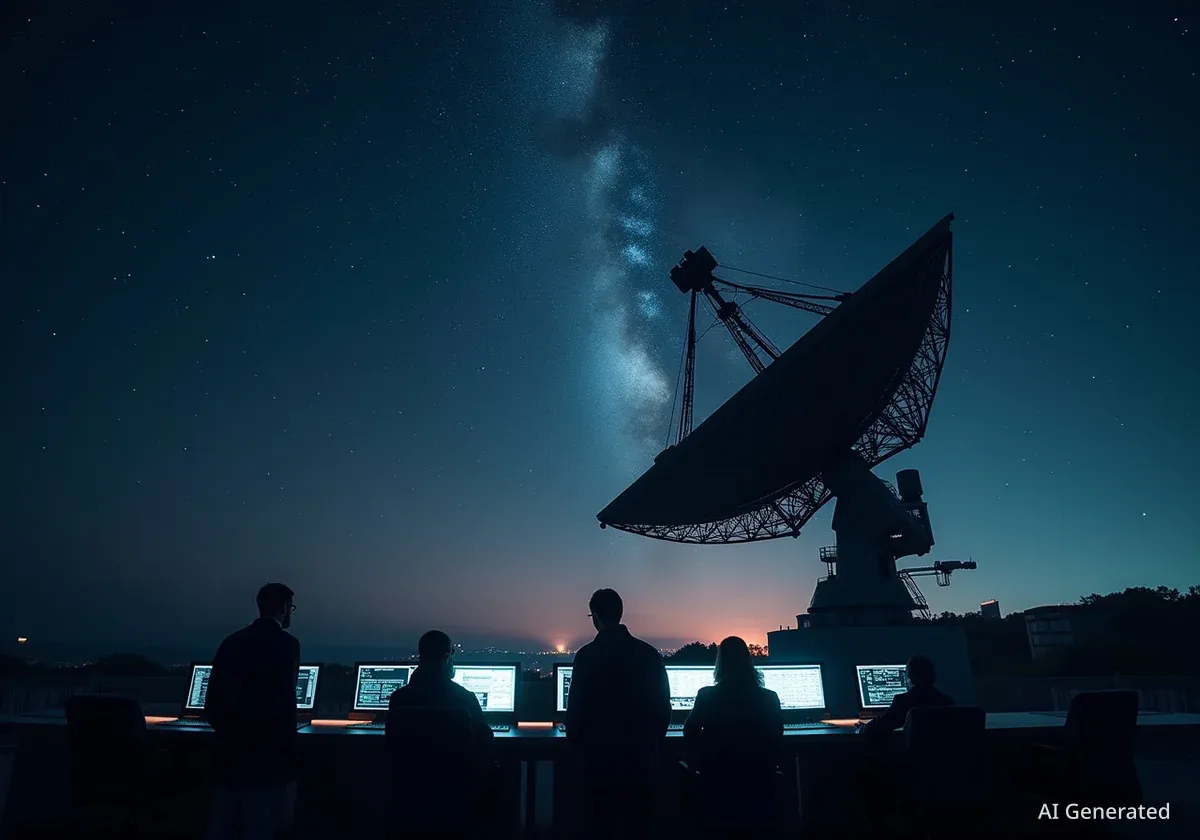Citizen scientists have identified three new examples of mysterious cosmic structures known as "odd radio circles," or ORCs. The discovery includes the most powerful and distant twin-ring system ever observed, providing new insights into the formation of these enormous celestial objects.
The findings, made by volunteers using the RAD@home Astronomy Collaboratory platform, suggest that these ghostly rings, which are invisible to optical telescopes, may be more common than previously thought. The research helps astronomers understand the complex interactions between supermassive black holes, galactic winds, and the vast spaces between galaxies.
Key Takeaways
- Citizen scientists discovered three new odd radio circles (ORCs), massive structures only visible in radio wavelengths.
- One discovery is a twin-ring system, the most distant and powerful ORC ever found, located 7 billion light-years away.
- The twin rings are nearly one million light-years across and are likely energized by powerful outflows from a central galaxy.
- The other two ORCs appear to be formed by the interaction of galactic jets with the hot gas in galaxy clusters.
- The discoveries were made through India's first citizen science platform, RAD@home, and confirmed with the LOFAR telescope network.
A New Class of Cosmic Objects
Odd radio circles are among the newest and most enigmatic discoveries in astronomy. First identified in 2019 by Dr. Anna Kapinska, these structures are immense, faint rings of radio emission that surround distant galaxies. They are completely invisible in optical, infrared, and X-ray light, making them detectable only with sensitive radio telescopes.
These objects are truly massive, with some spanning diameters up to 50 times that of our own Milky Way galaxy, which is about 100,000 light-years across. Before these new findings, only eight ORCs had been confirmed across the entire sky, making each new detection a critical piece of a complex puzzle.
"ORCs are among the most bizarre and beautiful cosmic structures we've ever seen, and they may hold vital clues about how galaxies and black holes co-evolve, hand-in-hand," said Ananda Hota of the University of Mumbai, who led the research.
The discoveries were made by volunteers analyzing data on the RAD@home platform, an initiative led by Hota. The observations were later confirmed using the Low Frequency Array (LOFAR), a network of radio antennas spread across Europe.
The Most Powerful Twin ORC System
One of the newly identified objects is the most remarkable ORC system found to date. Located approximately 7 billion light-years away, it is the second-ever discovery of a twin ORC system and is both the most distant and most powerful one known.
This system, associated with a radio galaxy cataloged as RAD J131346.9+500320, consists of two expanding rings. Together, these rings measure a staggering 978,000 light-years in diameter. They are embedded within a much larger, diffuse haze of radio emission that spans 2.6 million light-years.
Unprecedented Scale
The twin ORC system is so large that light would take nearly a million years to travel from one side of the rings to the other. The surrounding radio haze is more than 25 times the diameter of the Milky Way.
Researchers theorize that these rings are cosmic relics from a past, powerful event in the host galaxy. The team suggests that a "superwind" of radiation, likely generated by activity from the galaxy's central supermassive black hole or an intense period of star formation, is now re-energizing these ancient structures, causing them to glow in radio light.
Jets Interacting with Galactic Fog
The other two discoveries are located closer to Earth, at a distance of about 1.3 billion light-years. These ORCs appear to be directly linked to the powerful jets of charged particles that are blasted out from the supermassive black holes at the centers of their host galaxies.
All three host galaxies reside within massive galaxy clusters. These clusters are filled with a thin, extremely hot gas called the intra-cluster medium. The evidence suggests that the galactic jets are interacting with this medium, which acts like a cosmic wind that bends and shapes the jets.
What Are Radio Jets?
Supermassive black holes at the center of active galaxies can launch powerful beams of particles traveling near the speed of light. These "radio jets" spiral around magnetic field lines, producing radio waves through a process called synchrotron radiation. These jets can extend for millions of light-years into intergalactic space.
In one case, involving the galaxy RAD J122622.6+640622, a radio jet appears to bend and flow back toward the galaxy. At the point where the jet is diverted, a large ring of radio emission, about 100,000 light-years across, has formed. A similar process is observed in the third galaxy, RAD J142004.0+621715, where a jet also terminates in a large radio ring.
The Power of Citizen Science
These findings underscore the significant role that citizen science plays in modern astronomy. With vast amounts of data being generated by new telescopes, automated algorithms can sometimes miss unusual or faint structures. Human pattern recognition remains a powerful tool for discovery.
Pratik Dabhade of the National Center for Nuclear Research in Poland, a co-author of the study, highlighted this importance. "The fact that citizen scientists uncovered them highlights the continued importance of human pattern recognition, even in the age of machine learning," he stated.
The discoveries also change the perception of ORCs from isolated oddities to a more understood class of astronomical phenomena.
"These discoveries show that ORCs and radio rings are not isolated curiosities. They are part of a broader family of exotic plasma structures shaped by black-hole jets, winds and their environments," Dabhade added.
With the upcoming Square Kilometre Array (SKA) telescope network set to begin operations in the early 2030s, astronomers expect to find many more of these mysterious radio circles. The findings were published in the journal Monthly Notices of the Royal Astronomical Society.





